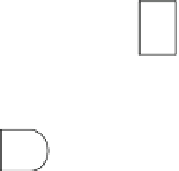Hardware Reference
In-Depth Information
a
b
b0
c
0
c
0
0
a
0
1
a
1/0
PO
PO
a1
a2
a1
a2
0
1
FF
FF
The circuit with two time frames
b
b
b0
b1
1/0
c
0
c
0
c
0
a
0
1
a
1/0
1
a
1/0
PO
PO
PO
a1
a2
a1
a2
a1
a2
0
1
1
FF
FF
FF
The circuit with three time frames
Fig. 3.15
LOC test for the circuit in Fig.
3.14
Using a three cycle test, with two activation cycles, the STR fault on a1 is detected
as shown by the 1/0 on output c in time frame 3. This example shows that TDFs
at some fault sites may not be detectable using LOC tests that use only one fault
activation cycle but may be detectable using tests with more than one activation
cycles. Similarly some TDFs not detected by two pattern LOS tests are detected by
LOS tests with multiple activation cycles (
Zhang et al.
2006
a).
In Table
3.4
results on TDF detection using multiple fault activation cycles are
given for ISCAS-89 circuits. After the circuit name the numbers of TDFs that can
be detected using enhanced scan are given. This is the maximum number of TDFs
that can be detected by any scan based tests. Next the numbers of faults detected
by single activation cycle using LOC, LOS and jointly by LOC and LOS tests are
given. Finally similar numbers are given when multiple activation cycles up to 11
are used. It can be seen that using multiple activation cycles and both LOC and LOS
test methods, for most of the benchmark circuits, the same fault coverage as that
achievable using enhanced scan can be achieved.
3.2.4
Tests for Small Delay Defects
In order to improve delay defect coverage whilst keeping the advantages of TDF
model, it has been proposed to use tests that activate and propagate TDF faults
through longest paths (
Pramanick et al.
1989
,
Majhi et al.
1996
,
Shao et al.
2002
)
.
Following is a brief review of one of these works (
Shao et al.
2002
).
faults are activated and how they are propagated to observed outputs. In Table
3.5
SNRB and WNRB stand for strong non-robust and weak non-robust. Note that in
this classification robust activation and propagation are considered as contained in





































